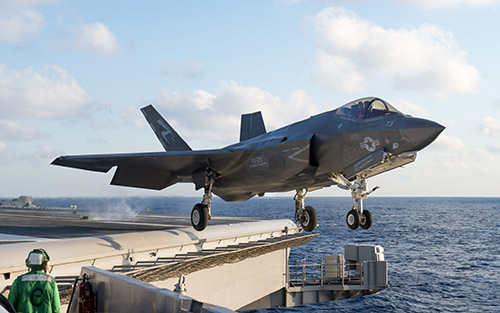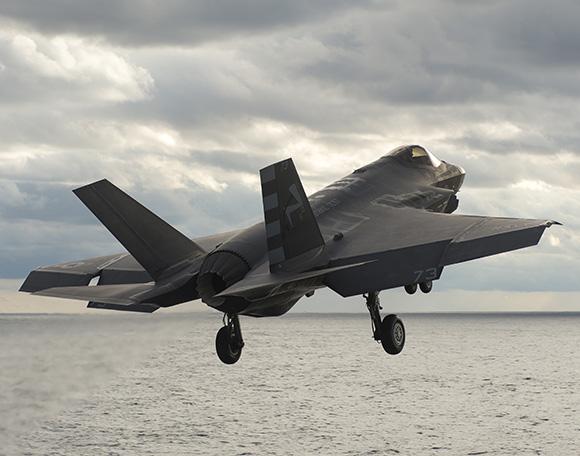Two F-35Cs have successfully completed the second test series aboard the USS Dwight D. Eisenhower aircraft carrier. The tests took place at 100 miles off the coast of Norfolk, Virginia. The pilots performed numerous night flights using the new helmets redesigned by Rockwell Collins. Test the ability of the fighter to take off at reduced speed (compared to the safety standard), with the use of post-burners and with heavier loads. A catapult throws an F-35C at 150 miles per hour in less than two seconds.
The F-35C tests are complete at 80%. The next tests, considered fundamental to reach the Initial Operational Capacity, will take place next summer. The Marine Corps, the first Corps to declare the F-35B operational, have more than fifty authorized and more than 400 military pilots specialized in maintenance.
The first VMFA-121 squadron will be transferred to the Iwakuni base in Japan in January of the 2017 to respond to possible crises in the Region. The Marine squadron, called '1 Group', presents most of the hardware changes already implemented (and that tomorrow will be integrated into mass production) such as reinforced bulkheads. The aircraft could go into battle with 'reduced' equipment: AIM-120 AMRAAM missiles, GBU-12 bombs and GBU-39.
According to the Marine Corps Aviation Plan, the F-35 will replace the entire EA-6B Prowler fleet within the 2019 and will displace the AV-8B Harrier from the 2026. Finally, the F-35 will detect the beloved F / A-18 Hornet in the 2030.
The Air Force will reach the Initial Operational Capacity of the F-35A as soon as the first squadron formed by 12-24 aircraft was formed, with trained airmen and crews able to carry out close air support missions, interdiction and limited suppression and destruction of enemy anti-aircraft defenses. The F-35A will reach the Initial Operational Capacity between August and December of the 2016.
Finally, the US Navy, equipped with the F-35C, will reach the Initial Operational Capacity as soon as the first squadron of 10 aircraft will be formed, with personnel and pilots of the navy trained and able to carry out the assigned missions. The F-35C will reach the Initial Operational Capacity between August 2018 and February 2019.

The development strategy of the JSF program is based on the implementation of software that from time to time increases platform capabilities. Funds for the final Block-4 have been allocated to date. The F-35 flying in the 2040 will be equipped with Block-7.
The 1A / 1B Block includes the 78 percent of the source code necessary for the F-35 Initial Operating Skills by providing training software and primary interaction between the various main systems.
The Block-2A is the software currently "loaded" on the F-35 fleet. Increases the aircraft's overall capabilities for pilot training including off-board fusion capabilities, initial data links, electronic countermeasures and improved debrief. With the 2A block, 86 per cent of the code necessary to reach the Initial Operational Capacity is provided. The Marine Corps with the F-35B has reached the Initial Operational Capacity with the 2B software block. The 2B provides basic Close Air Support with the possibility of launching AMRAAM (Advanced Medium Range Air to Air Missile), JDAM (Joint Direct Attack Munition) and GBU-12 (laser-guided aerial bomb). At 13 in October, between 60 and 75% of the American F-35 fleet has loaded the 2B. It should be noted that the Marine-tested F-35B is equipped with a special version of the Block 2B software. Recall that the 'B' version presents problems on sharing data collected by fighters in the configuration of four aircraft. The strategy adopted by the Marines is to fly 2 + 2 fighter formations. The merger of data on threats detected by a team of four fighters is not well managed by the current software. Consequently, the F-35 has some difficulties in identifying the real number of enemy targets on the radar. Better, therefore, to make them fly in pairs. The problems have been identified in the collective 'fusion' of the detected threats, one of the strengths of the future 'Game Changer'. The data transmitted to the pilots, at times, are not the real ones.
Lockheed Martin will solve the problem with the 3F software block. Therefore, the Marines will make the F-35 fly in pairs instead of four. This configuration showed greater reliability and low levels of false alarms, absolutely manageable. The Air Force plans to achieve Initial Operational Capacity with the F-35A in the 2016 with the next iteration of the software, called 3i. Described as a technical update of the Block-2B, the 3i will allow the aircraft to use JDAM, GBU-12 and AMRAAM. The F-35A will have substantial air support capabilities only in the 2018, when it reaches Full Operational Capability. Only in the 2019 (except for sensational delays), the F-35A can fire with the internal cannon and release a series of ammunition including AIM-9X, AMRAAM, GBU-12, GBU-31 and Small Diameter Bomb II. The Block 3F software will provide the 100 per cent of the 'Warfighting' capabilities of the fighter, with total integration of all external systems. The Block 3F was written, according to the latest information from Lockheed, and is being tested.
 The Small Diameter Bomb II (SDB-II) system will be integrated with Block-4a software. Block 4 will be divided into two segments. Block-4a will be ready between 2021 and 2022, while 4B for 2023. The twelve million dollars to write Block-4 have been included in the 2014 budget. A large part of the development of Block-4 will be dedicated to countermeasures against existing enemy air defense systems and with those that will arise in future years.
The Small Diameter Bomb II (SDB-II) system will be integrated with Block-4a software. Block 4 will be divided into two segments. Block-4a will be ready between 2021 and 2022, while 4B for 2023. The twelve million dollars to write Block-4 have been included in the 2014 budget. A large part of the development of Block-4 will be dedicated to countermeasures against existing enemy air defense systems and with those that will arise in future years.
Regarding the possible revisiting of the fighters that the Pentagon could order, as proposed by the Defense Planning Guidance, General Jon Davis, deputy commander of the Marine aviation. It was clear: "The F-35 will have to be 2443 as expected. We have F-18, Harrier and Prowler in service for more than 20 / 30 years. Our air fleet needs those 2443 F-35 and the Corps of Marine wants its 420 JSF ".
The 55 years of life of the F-35 fighter will cost the United States 1500 billions of dollars. In addition to the United States, hunting was ordered by Great Britain, Australia, Italy, Turkey, Norway, the Netherlands, Japan, South Korea and Israel.
(photo: Lockheed Martin / Raytheon)












